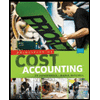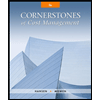
1.
Concept Introduction:
Cycle efficiency: It measures the amount of time that is spent in processing as compared to non-value-added time. Non-value-added time includes the time spent moving, inspecting, and waiting.
The total non-value added time using the traditional approach.
2.
Concept Introduction:
Cycle efficiency: It measures the amount of time that is spent in processing as compared to non-value-added time. Non-value-added time includes the time spent moving, inspecting, and waiting.
The cycle efficiency under the traditional approach.
3.
Concept Introduction:
Cycle efficiency: It measures the amount of time that is spent in processing as compared to non-value-added time. Non-value-added time includes the time spent moving, inspecting, and waiting.
The total non-value added time using the lean approach.
4.
Concept Introduction:
Cycle efficiency: It measures the amount of time that is spent in processing as compared to non-value-added time. Non-value-added time includes the time spent moving, inspecting, and waiting.
The cycle efficiency under the traditional approach.
5.
Concept Introduction:
Cycle efficiency: It measures the amount of time that is spent in processing as compared to non-value-added time. Non-value-added time includes the time spent moving, inspecting, and waiting.
If cycle efficiency is improved in the lean approach.
Want to see the full answer?
Check out a sample textbook solution
Chapter D Solutions
FUNDAMENTAL ACCT PRINCIPLES LL W CONNECT
- The standard cost of Winter Boots includes 4 units of direct materials at $7.50 per unit. During October, the company buys 35,000 units of direct materials at $7.20 and uses those materials to produce 8,500 units. Compute the total, price, and quantity variances for materials.arrow_forwardAccounting answer pleasearrow_forwardCan you solve this general accounting problem with appropriate steps and explanations?arrow_forward
- Solve this question and general accountingarrow_forwardPlease explain the solution to this general accounting problem with accurate explanations.arrow_forwardRead The company events occured during the first half of the year and answer the following questions: 1)Determine the importance of the company having property, plant, and equipment as part of the long-term assets on its balance sheet. 2)What are the costs for determining what is included in the acquisition of property, plant, and equipment? 3)What are the methods you can use to calculate depreciation? Which method makes the most sense for this company? 4)Taking into account the disposal of property, plant, and equipment, what is the correct way to record a disposal?arrow_forward
 Managerial Accounting: The Cornerstone of Busines...AccountingISBN:9781337115773Author:Maryanne M. Mowen, Don R. Hansen, Dan L. HeitgerPublisher:Cengage Learning
Managerial Accounting: The Cornerstone of Busines...AccountingISBN:9781337115773Author:Maryanne M. Mowen, Don R. Hansen, Dan L. HeitgerPublisher:Cengage Learning Managerial AccountingAccountingISBN:9781337912020Author:Carl Warren, Ph.d. Cma William B. TaylerPublisher:South-Western College Pub
Managerial AccountingAccountingISBN:9781337912020Author:Carl Warren, Ph.d. Cma William B. TaylerPublisher:South-Western College Pub Principles of Cost AccountingAccountingISBN:9781305087408Author:Edward J. Vanderbeck, Maria R. MitchellPublisher:Cengage Learning
Principles of Cost AccountingAccountingISBN:9781305087408Author:Edward J. Vanderbeck, Maria R. MitchellPublisher:Cengage Learning- Principles of Accounting Volume 2AccountingISBN:9781947172609Author:OpenStaxPublisher:OpenStax College
 Cornerstones of Cost Management (Cornerstones Ser...AccountingISBN:9781305970663Author:Don R. Hansen, Maryanne M. MowenPublisher:Cengage Learning
Cornerstones of Cost Management (Cornerstones Ser...AccountingISBN:9781305970663Author:Don R. Hansen, Maryanne M. MowenPublisher:Cengage Learning Financial And Managerial AccountingAccountingISBN:9781337902663Author:WARREN, Carl S.Publisher:Cengage Learning,
Financial And Managerial AccountingAccountingISBN:9781337902663Author:WARREN, Carl S.Publisher:Cengage Learning,





